There was an interesting article in Ad Age entitled “What I Learned From Working at P&G,” in which a number of highly placed alums reflect on the lessons they took with them. My partner, Jim, pointed out that a lot of the language was grounded in the metaphor of science–not surprising for a company that employs more PhDs than any university in the world. The key metaphors of marketing are war, science and story. P&G champions the science metaphor and does a nice job of leading by science. It is clearly their strongest suit and gives them a significant competitive advantage. But Procter & Gamble has been struggling for the past few years, leading us to speculate on the way that mastery of any particular metaphor may impart both strength and vulnerability at the same time.
For example, most of the former P&G execs pointed to a relentless focus on the consumer as a principal lesson from their time at the company. Significantly, what they describe is the focus of a scientist observing an experimental subject, not a storyteller reaching to connect with an audience. This way of thinking is a strength when it comes to identifying consumer needs and developing products to meet those needs. And it is a weakness when it comes to connecting with people emotionally. That weakness shows up in categories like beauty care, where a lot of the story energy is driven by a conflict we might characterize as medicine versus magic. The company’s strong preference for science often leads it to default to communication about efficacy and features at the expense of a richer, emotionally engaging story.
A big difference between the A. G. Lafley/Jim Stengel era and the current regime at P&G is that A. G. seemed to infuse the whole organization with heart in a subtle but important way. With Jim leading marketing, story seemed to gain traction without compromising P&G’s strength in science–a powerful combination. This is difficult to prove, but I’ve spoken with a number of people close to the company who agree. If they are right, then the waxing and waning of strategic capability in story is responsible for billions of dollars gained and lost in market capitalization.
Walmart and McDonald’s seem to champion the war metaphor. This is apparent in the way they are organized. Each is a massive organization that operates with a weird kind of agility and efficiency given its size. Like an effective army, they are more fractal than hierarchical. Each division of the organization, right down to the individual restaurants or stores, is a fractal of the whole organization and can operate with a fair amount of autonomy in pursuit of victory for the company as a whole. This ability gives these huge organizations a competitive advantage, but it also explains why they sometimes have a hard time distinguishing between what’s urgent and what’s important. It also explains why their customers may, from time to time, feel more like pawns in a giant battle than honored guests.
It’s harder to find champions of the story metaphor because even brands that start off rooted in a powerful story seem to drift in and out of it over time. We think this is because most people still use story intuitively, without understanding how it works. Story has great power to create emotional connection, but using it intuitively makes it very difficult for a charismatic leader to institutionalize the story effectively. Even companies that have used this metaphor quite powerfully (e.g., Disney, Apple, Nike) have drifted off story at critical moments in their history. In order to use story in a rigorous and strategic way, you have to consciously embrace the metaphor, and you have to understand how it is different from the war or science approach.
At the end of the day, no one succeeds in marketing without, to some extent, employing all three metaphors. But any metaphor can be a trap if you start to mistake it for truth. Companies whose previous success was powered by strength in war or science generally have a hard time articulating their story in an emotionally compelling way. And they have a particularly difficult time staying on story when they are being flanked by a more nimble challenger.
There are examples of category leaders who have rediscovered their story and used it to fight off a serious challenge–Old Spice is one with which I am very familiar. If you can think of others, I would love to hear your thoughts.
